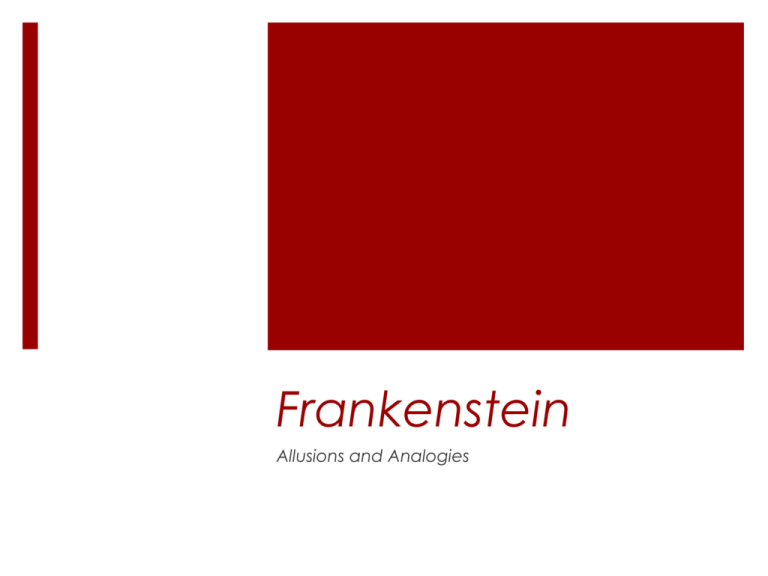Mary Shelley and FRANKENSTEIN Allusions and Analogies
advertisement

Frankenstein Allusions and Analogies Reminders If Mrs. Coates is writing you a recommendation and you are NOT using the Common App, you need to provide ME an addressed, stamped envelope for each college, and I will give them to her. Frankenstein test NEXT CLASS MWDS DUE: NEXT CLASS Must turn in ONE typed copy per group with Pledge stapled to front Must upload document in turnitin.com by MIDNIGHT Friday night The Things They Carried Due: Book Due: A Day- 10/15 B Day- 10/16 Study Guide Due: A Day- 10/17 B Day- 10/20 Study Guide that MUST be printed and uploaded in turnitin.com Early Life August 30, 1797: Born in London Only child of two notable intellectual radicals William Goodwin: philosopher; believed all human institutions were corrupt Mary Wollstonecraft: pioneering feminist; died only ten days after daughter’s birth Mary Jane Clairmont (widow): married William Goodwin four years after wife’s death Relationship between stepmother and daughter strained Friends of Shelley’s Friends of father Charles Lamb (writer and essayist) Samuel Taylor Coleridge (“Rime of the Ancient Mariner”) Friends of daughter Percy Blysshe Shelley Lord Byron (had affair and impregnated Shelley’s stepsister, Claire) Percy and Mary Shelley Began relationship in spring of 1814, as he was a frequent visitor to the Goodwin home Eloped in summer of 1814 when Mary was 17 (Percy already married with one young daughter and a child on the way ) Became pregnant immediately (premature daughter died) Father refused to speak to Mary after elopement (lasted 2 ½ years) Mary is a social outcast because she ran away with a married man. She must live separately from Percy 1816: gave birth to William October 1816: Percy’s wife drowned herself (while pregnant with their third child) Mary and Percy marry; Mary reconciles with father Had five children total; only one lived to adulthood (Percy Florence) July 1822: Percy Shelley drowns. February 1, 1851: Died in London at age of 53 Frankenstein and “Rime of the Ancient Mariner” Antarctic/Arctic Ships trapped in ice Victor and Mariner defy God, which disturbs the natural order of their world World transformed into a nightmare vision of an alien universe, a meaningless and terrifying wasteland, a world without God. Monster also experiences godless world (full of corrupt individuals who are irresponsible and cruel) Mariner, Victor and Creature alienated; no longer at peace with self or wider community Punishment: continue living despite desire to die; those closest must pay. Mariner and Victor seek redemption by continuing on journey. Mariner tries to pray; Victor tries to find Creature and destroy him. “Did I request thee, Maker, from my clay / To mold me man? Did I solicit thee / From darkness to promote me?” This quotation appears on the title page of Mary Shelley’s Frankenstein. It could have been spoken by Frankenstein’s creature. In fact, the words come from John Milton’s poem Paradise Lost (1667) and are spoken by the character of Adam. This booklength poem is a retelling of the story of Adam and Eve from the Bible. An equally prominent character in the poem is Satan, the lord of evil. Milton depicts Satan as the chief angel of heaven who rebels against God and is cast into hell. To avenge himself, he tempts Adam and Eve to disobey God in the Garden of Eden. **The McGraw-Hill Company, Inc. Read Paradise Lost Summary Do NOT write on copy For each BOOK assigned, record one-sentence summary. Look at Allusions and Analogies in Frankenstein handout Beside each quote for Paradise Lost, write down what we learn about the creature from each reference Beside each quote for “Rime of the Ancient Mariner,” write down what we learn about Walton, Frankenstein and the plot from each reference SKIP Prometheus Allusions Read Allusions to Shelley’s life: How does Frankenstein allude to her life? Read “Frankenstein’s Monster and Milton’s Satan” Make chart comparing Adam and Creature Satan and Creature Adam and Frankenstein Make a list of themes Goal: Explain the purpose of using allusions in Frankenstein. Frankenstein and Paradise Lost Adam and Creature Perfect at his creation; full of love for humanity and nature Turned to a life of evil and hardship by outside forces beyond his control Circumstance beyond both character’s control that led to a life of sin and hardship No others like self; seek companionship Frankenstein and Paradise Lost Satan and Creature Created to be beautiful Falls from creator’s grace and becomes perversion of beauty Neither directly attack his creator in retaliation; instead, they attack those closest to creator, causing more pain than direct attack Frankenstein and Paradise Lost Adam and Frankenstein Brings downfall by making a choice to attain knowledge that he should not have Themes Man, left to his own devices, is inherently good. (Romantic idea) Rejection of one’s offspring (something created to be great and beautiful can be easily perverted into something loathsome and utterly different from its intended purpose) Happiness and peace lie in close companions who complete the person (Romantic idea) Man has the ability to know things that make him “not much less than God,” but man should not partake of that knowledge Goal of using allusions Illuminate many central ideas of the work Add to characterization Bibliography Most of the information on this PowerPoint from: York Notes Advanced: Frankenstein Unless otherwise stated









